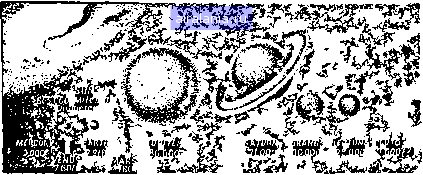

|
|
Главная -> Английский язык 0 1 2 3 4 5 6 7 8 9 10 11 12 13 14 15 16 17 18 19 20 21 22 23 24 25 26 27 28 29 30 31 32 33 34 35 36 37 38 39 40 41 42 43 44 45 46 47 48 49 50 51 52 53 54 55 56 57 58 59 60 61 62 63 64 65 66 67 68 69 70 71 72 73 74 75 76 77 [78] 79 80 81 82 83 84 85 86 87 88 89 90 91 92 93 94 95 96 97 98 99 100 101 102 103 104 105 106 107 108 109 110 111 112 113 114 115 116 117 118 119 120 121 122 123 124 125 126 127 128 129 130 131 132 133 134 135 136 137 138 139 140 141 142 143 144 145 146 147 148 All usable forms of energy on tfie Eartfis surface, witfi tfie exception of atomic and ttiermonuclear energy, are directly or indirectly due to the storing or conversion of energy imparted by the sun. The Planets. The planet closest to the Sun, Mercury, is difficult to observe because of its proximity to that body; hence, our knowledge of its physical characteristics is less accurate than of some of the other members of the solar system. Mercury has no moon, and its mass is about one-twentieth that of the Earth. Mercury is not known to have any atmosphere, nor would a permanent gaseous envelope be expected to occur under the conditions existing on the planet. In dimensions and mass Venus is somewhat smaller than the Earth. The interplanetary stations Venera 5 and Venera 6 reached the planet on May 16 and 17, 1969 and made measurements of Venus night-side atmosphere in the equatorial plane. The temperature, density and pressure results obtained with Venera 5 and Venera 6 provide a tentative model of the night-side planetary atmosphere. According to Venera 5 the surface pressure is 142 atm and the corresponding temperature 830° K. Much more complete information is available about Mars. Wifli a diameter half-way between that of the moon and the Earth, and a rate of revolution and inclination of Equator to orbital plane closely similar to those of the Earth, it has an appreciable atmosphere and its surface markings exhibit seasonal changes in coloration. Its white polar caps, appearing in winter and vanishing in summer are, apparently thin layers of frozen water fractions of an inch to several inches in thickness. At opposition, that is, when the two planets lie in the same direction from the Sun, the approximate distance between Earth and Mars ranges from 35 million to 60 million miles. Bleak and desert-like as Mars appears to be, with no free oxygen and little, if any, water, there is some evidence of life. According to the hypothesis of a well known Soviet scientist, Prof. G.A. Tikhov, the seasonal color changes, from green in spring to brown in autumn, may suggest vegetation. Mars 2, a Soviet Automatic Interplanetary Station, was sent to Mars on May 19, 1971. It was followed by Mars 3, sent on May 28, 1971. Since November 27 and December 2, 1971, the two Soviet probes are orbiting Mars and have taken photographs of its surface giving important data on planets geological structure. The four members of the group of the giant planets have so many characteristics in common that they may well be treated together. They are all massive bodies of low density and large diameter and they all rotate rapidly. Because of their low densities (0.7 to 1.6 times the density of water) and on the basis of spectral information, they all are thought to have a "rock-in-a-snowball structure - that is, a small dense rocky core surrounded by a thick shell of ice and covered by thousands of miles of compressed hydrogen and helium. Methane and ammonia also known to be present are minor constituents. Because of the low intensities of solar radiation at the distances of the giant planets, temperatures at the visible upper atmospheric surfaces range from -200° to -300°F. Almost nothing is known about Pluto, the most distant member of the known solar system, except its orbital characteristics and the fact that it is extremely cold, with a small radius and a mass about 80 per cent that of the Earth. The Planets
 The sizes of the planets (but not their distances) are diagramed in relation to a section of the Sun, КОНТРОЛЬНЫЕ ВОПРОСЫ 1. Какая конструкция называется эллиптической (§ 100)? 2. Какие элементы предложения чаще всего опускаются (§ 100)? 3. Где раскрывается лексическое значение опущенного подлежащего: А bullet cannot alter its course, while in flight; When in rapid motion, electrons can... 4. Укажите особенность перевода эллиптической конструкции с союзом whether: The aeroplanes, whether light or heavy... 5. Назовите возможные варианты перевода эллиптических конструкций с уступительными союзами: whatever the shape of the magnet...; no matter how weak the impulse...; ... however remote the planet... 6. Как переводится эллиптическая конструкция if any? 0 1 2 3 4 5 6 7 8 9 10 11 12 13 14 15 16 17 18 19 20 21 22 23 24 25 26 27 28 29 30 31 32 33 34 35 36 37 38 39 40 41 42 43 44 45 46 47 48 49 50 51 52 53 54 55 56 57 58 59 60 61 62 63 64 65 66 67 68 69 70 71 72 73 74 75 76 77 [78] 79 80 81 82 83 84 85 86 87 88 89 90 91 92 93 94 95 96 97 98 99 100 101 102 103 104 105 106 107 108 109 110 111 112 113 114 115 116 117 118 119 120 121 122 123 124 125 126 127 128 129 130 131 132 133 134 135 136 137 138 139 140 141 142 143 144 145 146 147 148 0.0134 |